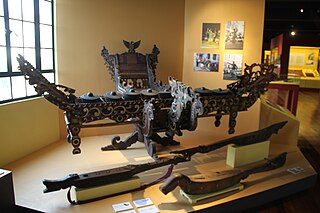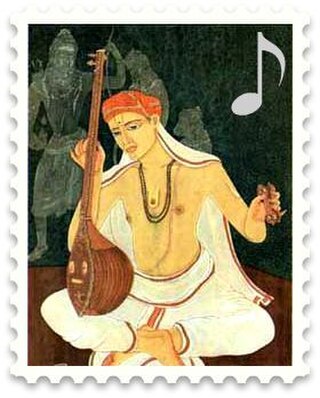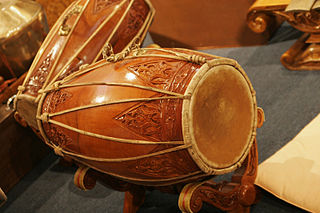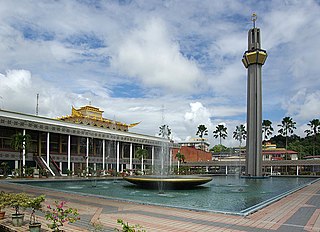
The xylophone is a musical instrument in the percussion family that consists of wooden bars struck by mallets. Like the glockenspiel, the xylophone essentially consists of a set of tuned wooden keys arranged in the fashion of the keyboard of a piano. Each bar is an idiophone tuned to a pitch of a musical scale, whether pentatonic or heptatonic in the case of many African and Asian instruments, diatonic in many western children's instruments, or chromatic for orchestral use.

Gamelan is the traditional ensemble music of the Javanese, Sundanese, and Balinese peoples of Indonesia, made up predominantly of percussive instruments. The most common instruments used are metallophones and a set of hand-drums called kendang, which keep the beat. The kemanak, a banana-shaped idiophone, and the gangsa, another metallophone, are also commonly used gamelan instruments on Bali. Other notable instruments include xylophones, bamboo flutes, a bowed string instrument called a rebab, and a zither-like instrument called a siter, used in Javanese gamelan. Additionally, vocalists may be featured, being referred to as sindhen for females or gerong for males.

Music of Malaysia is the generic term for music that has been created in various genres in Malaysia. A great variety of genres in Malaysian music reflects the specific cultural groups within multiethnic Malaysian society: Malay, Chinese, Indian, Dayak, Kadazan-Dusun, Bajau, Orang Asli, Melanau, Kristang and others.

As it is a country with many different tribes and ethnic groups, the music of Indonesia itself is also very diverse, coming in hundreds of different forms and styles. Every region has its own culture and art, and as a result traditional music from area to area also uniquely differs from one another. For example, each traditional music are often accompanied by their very own dance and theatre. Contemporary music scene have also been heavily shaped by various foreign influences, such as America, Britain, Japan, Korea, and India.

Kulintang is a modern term for an ancient instrumental form of music composed on a row of small, horizontally laid gongs that function melodically, accompanied by larger, suspended gongs and drums. As part of the larger gong-chime culture of Southeast Asia, kulintang music ensembles have been playing for many centuries in regions of the Southern Philippines, Eastern Malaysia, Eastern Indonesia, Brunei and Timor, Kulintang evolved from a simple native signaling tradition, and developed into its present form with the incorporation of knobbed gongs from Sundanese people in Java Island, Indonesia. Its importance stems from its association with the indigenous cultures that inhabited these islands prior to the influences of Hinduism, Buddhism, Islam, Christianity or the West, making kulintang the most developed tradition of Southeast Asian archaic gong-chime ensembles.

The angklung is a musical instrument from the Sundanese people in Indonesia made of a varying number of bamboo tubes attached to a bamboo frame. The tubes are carved to have a resonant pitch when struck and are tuned to octaves, similar to Western handbells. The base of the frame is held in one hand, while the other hand shakes the instrument, causing a repeating note to sound. Each performer in an angklung ensemble is typically responsible for just one pitch, sounding their individual angklung at the appropriate times to produce complete melodies.

Music of Jammu and Kashmir reflects a rich musical heritage and cultural legacy of the Indian-administered union territory of Jammu and Kashmir. Two different regions of Jammu and Kashmir consists the Jammu region and Kashmir Valley. Music of Kashmir Valley has influences of Central Asian music while music from Jammu region is similar to that of other regions of North India.

A kendang or gendang is a two-headed drum used by people from the Indonesian Archipelago. The kendang is one of the primary instruments used in the gamelan ensembles of Javanese, Sundanese, and Balinese music. It is also used in various Kulintang ensembles in Indonesia, Brunei, Malaysia, Singapore, and the Philippines. It is constructed in a variety of ways by different ethnic groups. It is related to the Indian double-headed mridangam drum.

The Lapau, also known as the Royal Ceremonial Hall, is a ceremonial hall in Bandar Seri Begawan, Brunei. It is where the royal ceremonies, state investiture and some state events are traditionally held. It was the place where the present Sultan of Brunei, Sultan Hassanal Bolkiah, was crowned in 1968.

The Gamelan Sekaten is a ceremonial gamelan from central Java, Indonesia, played during the annual Sekaten festival. The word "sekaten" itself is derived from syahadatain or shahada, the first requirement for converting into Islamic faith. Traditionally it is played once per year, on the occasion of Mawlid, Muhammad's birthday, for the week from the 6-12 of the month of Mulud. On this celebration it is brought from the palace at 11 pm to two pavilions before the Great Mosque. It is played every day during that week except the Thursday night/Friday morning. On the eve of the birthday proper, it is returned at 11 pm.
The regalia of Malaysia includes all the items which are deemed sacred and symbolic of the supremacy and authority of the Yang di-Pertuan Agong or the Supreme King of Malaysia and his consort, the Raja Permaisuri Agong. The installation of the Supreme King is a very special ceremony. Only on this particular day are the masses able to see his regalia. Several of these are Malaysian National Treasures since 2009.

Gendang beleq is a dance and music performance from Lombok island, Indonesia. It is a popular performance among the native Sasak people.

The tube zither is a stringed musical instrument in which a tube functions both as an instrument's neck and its soundbox. As the neck, it holds strings taut and allows them to vibrate. As a soundbox, it modifies the sound and transfers it to the open air. The instruments are among the oldest of chordophones, being "a very early stage" in the development of chordophones, and predate some of the oldest chordophones, such as the Chinese Se, zithers built on a tube split in half. Most tube zithers are made of bamboo, played today in Madagascar, India, Southeast Asia and Taiwan. Tube zithers made from other materials have been found in Europe and the United States, made from materials such as cornstalks and cactus.

Tanjidor is a traditional Betawi musical ensemble developed in Jakarta, Indonesia. This musical ensemble took the form of a modest orchestra and was developed in the 19th century, pioneered by Augustijn Michiels better known as Major Jantje in the Citrap or Citeureup area on the outskirt of Batavia.

Gendang Beleq dance is a sacred folk dance tradition of Sasak people of Lombok in West Nusa Tenggara, Indonesia. This dance demonstrates dance performance with big drums, called gendang beleq.

Bongai also known as Rontak Kudo, is a traditional folk music genre from the Malaysian state of Negeri Sembilan. It can be sung as a solo, a duet or in a group with or without musical accompaniment.
Inai dance or Terinai dance is a traditional Malay dance. This dance is a court dance performed during the circumcision ceremony of the children of the palace dignitaries. It is presented to these children as they are about to be circumcised and sit on the throne. Inai dance is popular in Perlis, northern Kedah, and Kelantan. This Inai dance is rarely performed compared to other palace dances, as it is dedicated to certain events such as weddings, circumcisions, and royal coronations.

Traditional Malaysian instruments are the musical instruments used in the traditional and classical music of Malaysia. They comprise a wide range of wind, string, and percussion instruments, used by both the Malay majority as well as the nation's ethnic minorities.

A tifa totobuang is a music ensemble from the Maluku Islands, related to the kulintang orchestra. It consists of a set of a double row of gong chimes known as the totobuang and a set of tifa drums. It can also include a large gong.

Gordang sambilan is a kendang musical instrument originating from North Sumatra, Indonesia. Gordang sambilan consists of nine relatively large and long drums made of ingul wood and played by four people. The size and length of the nine drums are stratified, starting from the largest to the smallest.

















